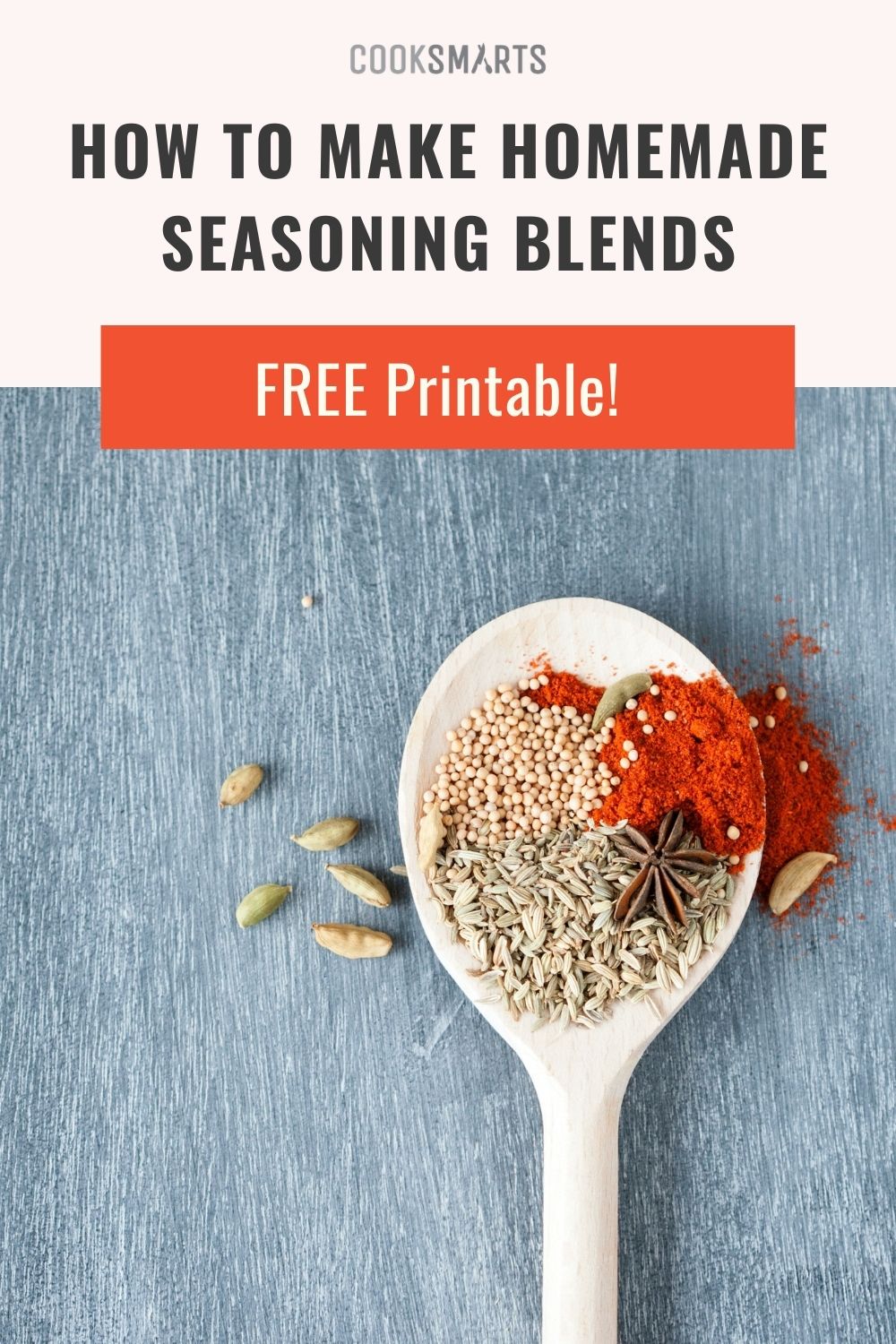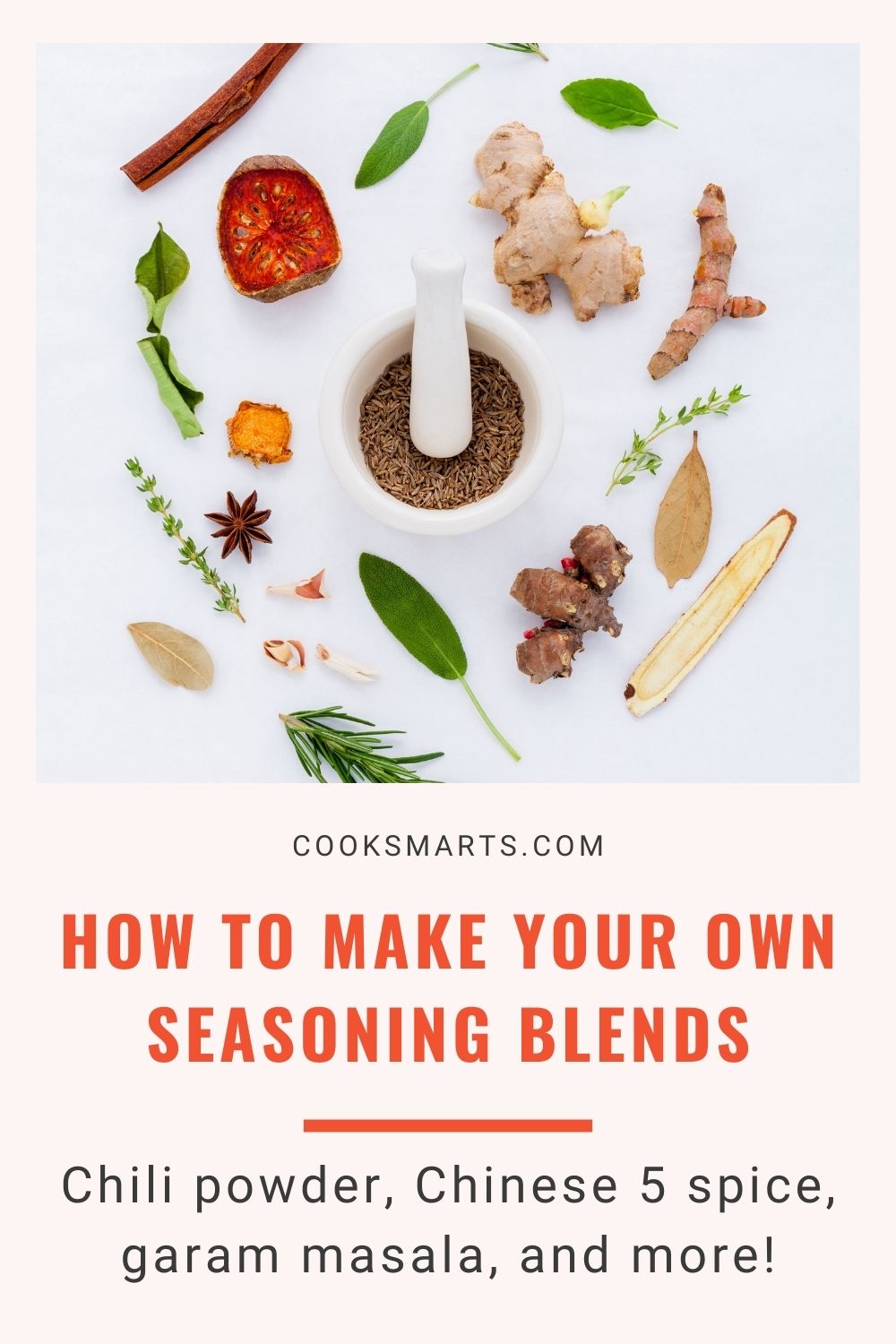Seasoning Blends (Free Downloadable Infographic)
If you’ve ever been curious exactly what is in Italian seasoning or how to make curry powder, look no further than our seasoning blends infographic. We’ll share our take on berbere spice, chili powder, Chinese 5 spice, garam masala, and more!
If you’ve ever been curious what spices go into your favorite spice blends, we’ve got you covered! Download our seasoning blends infographic for a handy reference for how to make — and use — all your favorite seasoning blends, including both spice mix and herb blend recipes.
Read on for which seasoning blends are included in the infographic, and more information about them.
12 Seasoning Blend Recipes

Keep your favorite seasoning blends on hand, so you can make cooking extra flavorful and easy.
Make Meals Flavorful and Easy
Keep these homemade seasoning blends on hand to make cooking a whole lot easier!
I acknowledge by requesting this info, I'll be added to Cook Smarts' newsletter list. I can unsubscribe at any time.
1. Berbere Spice
What is berbere spice? Berbere is an Ethiopian spice mix that’s peppery and fiery hot from cayenne and other savory spices, but also sweet from the inclusion of nutmeg, ginger, cinnamon, cardamom, and cloves — spices you might find in a pie or muffin.
How is it used? Berbere spice mix is great on berbere chicken and other meats, as well as roast vegetables. Although berbere seasoning can vary from recipe to recipe, our berbere recipe uses all the traditional flavors without including anything too hard to find.
2. Cajun Seasoning
What is cajun seasoning? This Cajun food staple includes spicy, earthy, zesty flavors such as paprika, garlic and onion powder, oregano and thyme, and spicy cayenne pepper.
How is it used? Cajun seasoning is essential for a Cajun boil. It also goes great on Cajun fries or Cajun chicken pasta, and in many other applications — throw it on popcorn or in a salad dressing if you want to get creative! Our Cajun seasoning recipe is hot without being overwhelming so the other flavors have a chance to shine too.
3. Chili Powder
What is chili powder? Not to be confused with chile powder — which is simply ground dried chiles — chili powder is a spicy, smoky mix of spices used to flavor chili.
How is it used? Whether you’re making crockpot chili or Instant Pot chili, white chicken chili or vegetarian chili, all the best chili recipes use chili powder! So if you’re just looking for an easy chili powder substitute, you may want to consider following our chili powder recipe instead so you’ll have plenty on hand for next time.
4. Chinese 5 Spice
What is Chinese 5 spice? Chinese 5 spice powder is a warm, sweet, bitter mix of — you guessed it! — 5 spices commonly used in Chinese cooking. Though the proportions in Chinese 5 spice recipes vary, the 5 spices are always cinnamon, Szechuan pepper, star anise, fennel seeds, and cloves.
How is it used? Frequently used in marinades, dry rubs, and sautés, Chinese 5 spice powder is great on beef, duck, pork, or tofu, as well as on any vegetables you’d commonly find in a stir-fry.
5. Curry Powder
What is curry powder? Curry powder is a warm, spicy, and savory blend often used in Indian cuisine. Although curry powder ingredients usually include turmeric, chili powder, cumin, and coriander, recipes vary widely — so if you’re wondering how to make curry powder, the answer is almost “Any way you want!” In other words, there really isn’t a great curry powder substitute, but you can customize to fit your own preferences. We’ll share our favorite curry powder recipe in this infographic.
How is it used? Most frequently used as an ingredient in curries, curry powder is also great in marinades, sautés, and soups. It goes great with chicken, pork, lentils, and tofu, and complements pretty much any vegetable you’d find in Indian cuisine — think broccoli, cauliflower, cabbage, green beans, and zucchini.
6. Dukkah Spice Blend
What is dukkah? Dukkah seasoning, also spelled “duqqa,” is an Egyptian spice blend made of nuts and seeds along with herbs and spices. It’s nutty and crunchy, which complements the rich, warm flavors of fennel, cumin, and coriander. The specific nuts used in dukkah spice vary, but typically include almonds, hazelnuts, and / or walnuts, and most dukkah recipes also use toasted sesame seeds (as does ours).
How is it used? Dukkah seasoning is often sprinkled over a finished dish to add an extra flavorful crunch. We like it on popcorn, in cold dips, or in compound butter, though you could also use it to garnish a salad, bowl of soup, or even a sandwich!
7. Everything Bagel Seasoning
What is everything bagel seasoning? To put it succinctly, it’s all the ingredients you’d find on an everything bagel from a bagel shop. So what is on an everything bagel? This rich, crunchy mixture typically consists of poppy seeds, sesame seeds, dried garlic, dried onion, and salt. We like to use both white and black sesame seeds for an attractive contrast, but feel free to use only one or the other!
How is it used? Everything bagel seasoning is delicious in everything bagel dip, or can be stirred into salad dressings or compound butter. It’s also a great way to finish a soup or stew, garnish a salad or other meal, or can be sprinkled on popcorn.
8. Garam Masala
What is garam masala? Sometimes misspelled “garam marsala,” garam masala is an Indian spice mix that’s warm, sweet, and bitter. Though it contains similar ingredients to curry powder, garam masala is not a curry powder substitute (and curry powder is not a garam masala substitute); garam masala is sweeter and more pungent. Rather, the 2 spice mixes complement each other and are often used together in dishes. Curious how to make garam masala powder? While garam masala ingredients vary, they typically include cumin, coriander, cardamom, cinnamon, cloves, nutmeg, and bay leaf. (Our garam masala recipe includes all of these.)
How is it used? A key ingredient in chicken garam masala, curries, and other Indian dishes, garam masala can also be used in marinades, salad dressings, and sautés. It’s great on beans, beef, chicken, and lentils, as well as Indian vegetables such as broccoli, cauliflower, green beans, potatoes, and squash.
9. Herbes de Provence
What are herbes de Provence? Literally, herbes de Provence are herbs from the Provence region of France. They’re an earthy, fragrant blend whose exact composition varies. Often written “herbs de Provence,” these herbs include thyme, oregano, rosemary, marjoram, sage, tarragon, and more, almost any combination of which could be used as an herbes de Provence substitute. Our herbes de Provence recipe uses traditional herbs, but you can also add lavender for a pretty North American variation.
How is it used? Often used on chicken, goat cheese, beef, fish, lamb, or chickpeas, herbes de Provence can be used as a dry rub or in marinades or salad dressings. They also give soups and stews a unique Southern French flair, or can be sprinkled on popcorn for a fun pop of flavor.
10. Italian Seasoning
What is Italian seasoning? Much like herbes de Provence are a blend of herbs you’d find in Provence, Italian seasoning is (wait for it) … herbs you’d find in Italian cuisine! There’s no need to search for a substitute for Italian seasoning because we keep our Italian seasoning recipe simple with just oregano, basil, thyme, and rosemary.
How is it used? Italian seasoning is delicious in sauces and bread dips, but go just as well in sautés, soups, and on popcorn. These Italian spices work well on beef, chicken, pork, and turkey, as well as a variety of vegetables, from tomatoes to sweet potatoes to eggplant. If you’re wondering how to make Italian seasoning, stop wondering and start measuring!
11. Ras El Hanout
What is ras el hanout? Sometimes miswritten as “ras al hanout,” this sweet and spicy Moroccan spice blend contains a multitude of spices ranging from clove, cinnamon, and ginger, to paprika, cumin, and turmeric. (The best part about making any ras el hanout recipe from scratch is seeing all the spices side by side before stirring them together! #instagramworthy)
How is it used? Frequently used in North African marinades, dry rubs, and soups, this spice mix is delicious on everything from beans to beef to fish, and can flavor fruits / veggies both sweet (such as dates and prunes) and savory (such as tomatoes and onions). There truly is no substitute for ras el hanout!
12. Za’atar Seasoning
What is za’atar? A staple of Middle Eastern cuisine, za’atar spice blend is a mix of herbs, often including thyme (our za’atar recipe keeps it simple and uses thyme as its only herb), alongside sesame seeds, sumac, and salt. It’s lightly bitter and warm.
How is it used? Some people use lemon pepper or a lemon zest and sesame seed mixture as a za’atar substitute, but there’s really no comparing it to the real thing! This craveable, crunchy seasoning can be used as a dry rub or tossed onto popcorn; it’s great in dips or compound butter; and it can add flavor to a marinade. We love it on za’atar chicken, root vegetables, eggplant, beef, fish, lamb, and more.
If these seasoning blend recipes are useful to you, stay tuned for more infographics and how-to articles by signing up for our weekly email below. Or sign up for a free 14-day trial of our meal plan service for delicious recipes to make with your new homemade spice blends!


